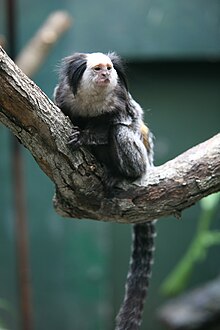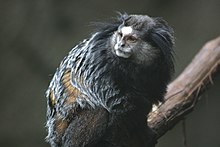Marmosets
| Marmosets | ||||||||||||
|---|---|---|---|---|---|---|---|---|---|---|---|---|

Common marmoset ( Callithrix jacchus ) |
||||||||||||
| Systematics | ||||||||||||
|
||||||||||||
| Scientific name | ||||||||||||
| Callithrix | ||||||||||||
| Erxleben , 1777 |


The marmosets or Marmosets ( Callithrix ) are a genus of marmosets from primates group of marmosets (Callitrichidae). There are six types.
features
These animals are 18 to 30 centimeters long, plus a tail up to 40 centimeters long. Their weight is 230 to 450 grams. Their fur is predominantly gray or black, sometimes the head and throat are colored in stark contrast. The white, yellow or black tufts on the ears are characteristic of the subgenus. The tail is extremely long and bushy, it is usually ringed black-gray. Like all marmosets, they have specialized teeth in the lower jaw: the canines are approximately the same height as the incisors and thus form a tool for gnawing the tree bark. The limbs are rather short, as in all marmosets there are claws instead of nails on the fingers and toes (with the exception of the big toe).
distribution and habitat
Tufted monkeys live exclusively in eastern and southeastern Brazil , their natural range extends from Maranhão and Tocantins to the state of São Paulo . In addition, they have been introduced in some regions where they were not originally native, such as Santa Catarina and the Argentine region of Buenos Aires . Tufted monkeys are more likely to inhabit dry forests, so they can be found in the cerrado as well as in the caatinga , but also in the rainforests on the Atlantic coast . Common marmosets are adaptable, they also occur in secondary forests , partially deforested areas and sometimes in gardens and plantations.
Way of life
Common marmosets, like all marmosets, are active during the day; at night they sleep in tree hollows or in thickets of plants. They are tree dwellers, there they either walk or jump on all fours.
They live together in groups of two to 15 animals. These groups are often organized around a fertile couple and can also include other adults and young animals. The reproductive couple dominates the group, the ovulation of the subordinate females is suppressed, so that they are not able to reproduce. In this suppression, pheromones from the dominant animals could play a role. The districts are relatively small, the territorial behavior is not pronounced. The group members communicate with each other through facial expressions, postures and sounds.
food
Like all marmosets, marmosets are able to gnaw holes in the tree bark thanks to their specialized teeth in order to get to the tree sap. This food plays a role especially in times when there are few fruits and seeds - another important source of food -. Another part of the diet are insects and spiders, sometimes they also consume eggs and small vertebrates.
Reproduction
Usually only the dominant female in a group will breed. After a gestation period of around 140 to 150 days, as with all marmosets, mostly dizygoti twins are born. These are very large, they weigh around 25% of the mother's weight. The father and the other group members participate intensively in the rearing of the young, they carry them and occupy themselves with them and give them to the mother only to suckle. After a few months, the young are weaned and sexually mature at around 12 to 18 months.
Systematics
A distinction is made between six types [the distribution area in square brackets on the map on the right]:
- Yellow-bored tufted monkey or white brush monkey ( Callithrix aurita ), [blue]
- Yellow-headed marmoset ( Callithrix flaviceps ), [light green]
- White-headed marmoset ( Callithrix geoffroyi ), [purple]
- Common marmoset ( Callithrix jacchus ), [yellow]
- Great cow monkey ( Callithrix kuhlii ), [dark green]
- Black marmoset or black brush monkey ( Callithrix penicillata ), [red].
Together with the marmoset (genus Mico ) and Pygmy Marmoset (genus Cebuella ) the marmosets form the group of marmosets within the family of marmosets (Callitrichidae).
literature
- Thomas Geissmann : Comparative Primatology. Springer-Verlag, Berlin et al. 2003, ISBN 3-540-43645-6 .
- Russell A. Mittermeier , Anthony B. Rylands & Don E. Wilson : Handbook of the Mammals of the World: Primates: 3rd 2013, ISBN 978-8496553897
- Ronald M. Nowak: Walker's Mammals of the World. 6th edition. Johns Hopkins University Press, Baltimore MD 1999, ISBN 0-8018-5789-9 .
- Don E. Wilson, DeeAnn M. Reeder (Eds.): Mammal Species of the World. A taxonomic and geographic Reference. Johns Hopkins University Press, Baltimore MD 2005, ISBN 0-8018-8221-4 .
